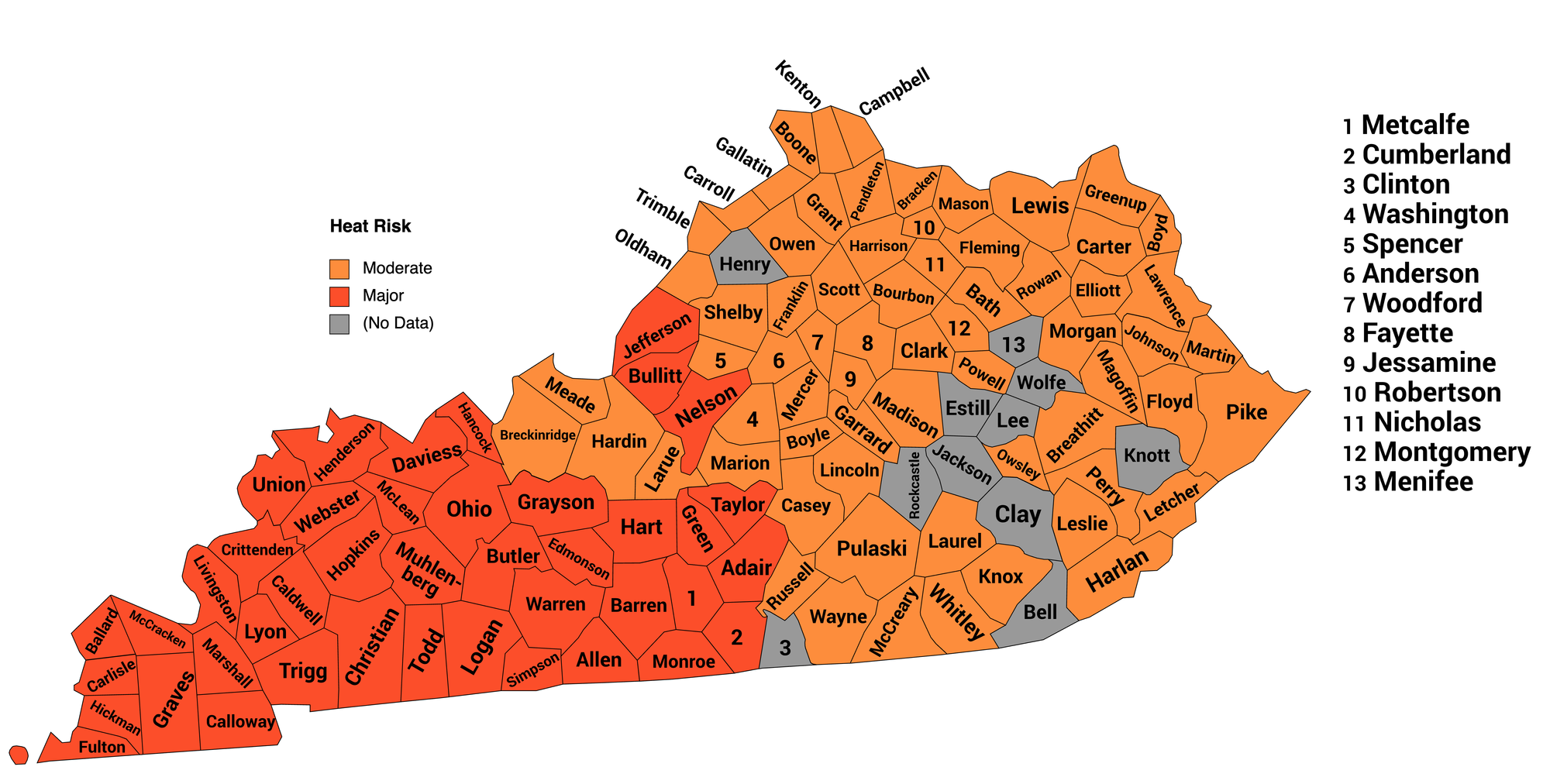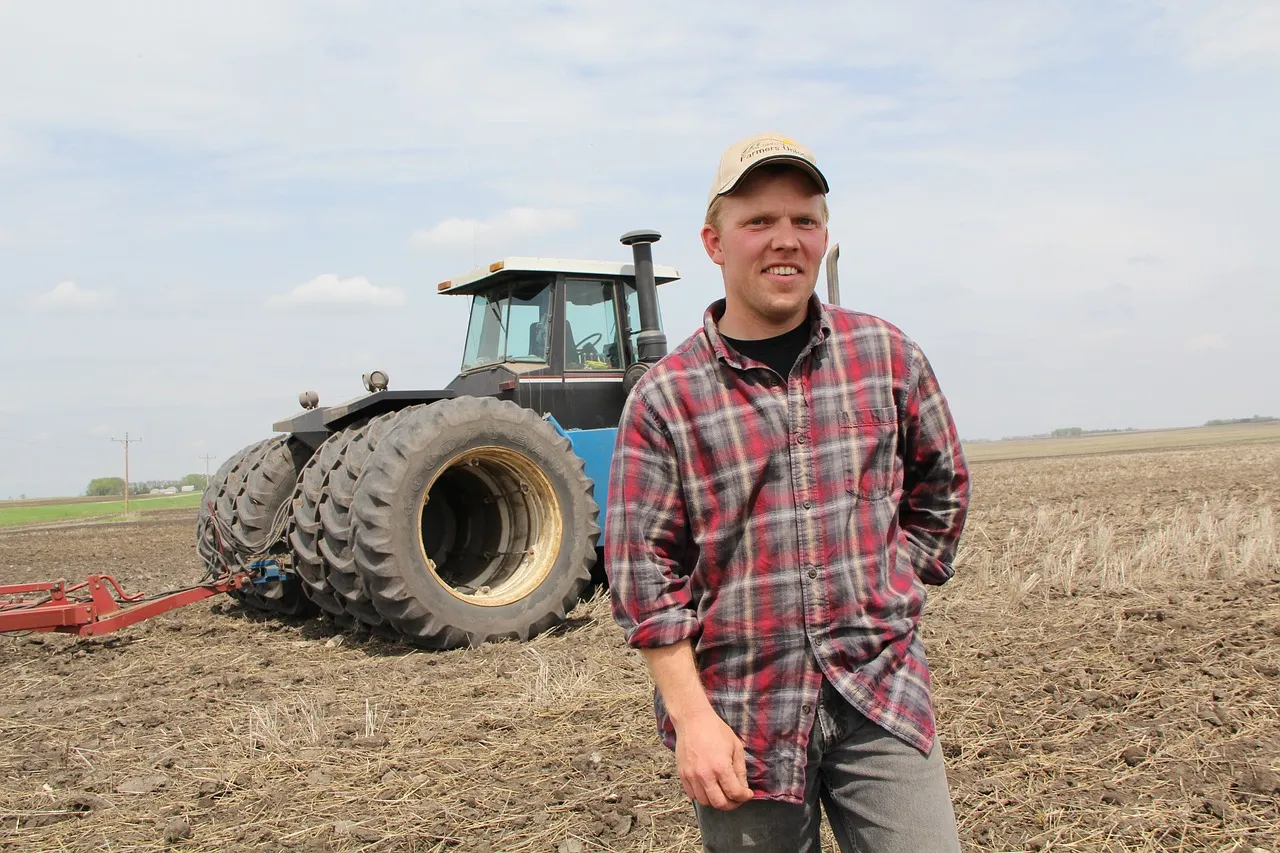The fourth article in the climate risk series
According to the First Street Foundation, heat is one of the main threats to Kentucky due to climate change. In the western part of the state, particularly, climate change is going to bring significant increases and even extremes in terms of heat and the heat index.
And yet, when you look at the heat risk map for the state, you notice that unlike our other maps, you see that the highest risk for any county is the Major category – which, if you’ve been following along through these articles, you know is only a 3 rating on a scale of 5.
I spoke with one of the data scientists at First Street, and it was as I expected: yes, we are going to experience serious temperature impacts from climate change, and it will be serious – but, as serious as our risk is to our state, it pales in comparison to other states.
To illustrate that, I’m doing something I haven’t done for the other three stories – include the national map so you can see what I am talking about.

Having said all that, our heat risk from climate change is still formidable, as shown by First Street’s Extreme Heat Model. As they note, it is the “nation’s most comprehensive, peer-reviewed extreme heat model. The first-of-its-kind methodology analyzes temperature hazards, projects future climate scenarios, incorporates local land surface characteristics, and validates against satellite imagery and government records. The model is a spatial temperature model that determines a specific location’s exposure to extreme heat. At a high level, the model incorporates vegetation, elevation, urbanization, and distance to water bodies and coastlines.”
Let’s look, then, at Kentucky’s risk of extreme heat caused by climate change.
Map of Heat Risk across Kentucky
Here is the map of heat risk by county.

Heat Risk Data Table
And here is the underlying data. You can sort the table by clicking on a column header.
| County | Heat Risk |
|---|---|
| Anderson | 2 |
| Bath | 2 |
| Boone | 2 |
| Bourbon | 2 |
| Boyd | 2 |
| Boyle | 2 |
| Bracken | 2 |
| Breathitt | 2 |
| Breckinridge | 2 |
| Campbell | 2 |
| Carroll | 2 |
| Carter | 2 |
| Casey | 2 |
| Clark | 2 |
| Elliott | 2 |
| Fayette | 2 |
| Fleming | 2 |
| Floyd | 2 |
| Franklin | 2 |
| Gallatin | 2 |
| Garrard | 2 |
| Grant | 2 |
| Greenup | 2 |
| Hardin | 2 |
| Harlan | 2 |
| Harrison | 2 |
| Jessamine | 2 |
| Johnson | 2 |
| Kenton | 2 |
| Knox | 2 |
| Larue | 2 |
| Laurel | 2 |
| Lawrence | 2 |
| Leslie | 2 |
| Letcher | 2 |
| Lewis | 2 |
| Lincoln | 2 |
| Madison | 2 |
| Magoffin | 2 |
| Marion | 2 |
| Martin | 2 |
| Mason | 2 |
| McCreary | 2 |
| Meade | 2 |
| Mercer | 2 |
| Montgomery | 2 |
| Morgan | 2 |
| Nicholas | 2 |
| Oldham | 2 |
| Owen | 2 |
| Owsley | 2 |
| Pendleton | 2 |
| Perry | 2 |
| Pike | 2 |
| Powell | 2 |
| Pulaski | 2 |
| Robertson | 2 |
| Rowan | 2 |
| Russell | 2 |
| Scott | 2 |
| Shelby | 2 |
| Spencer | 2 |
| Trimble | 2 |
| Washington | 2 |
| Wayne | 2 |
| Whitley | 2 |
| Woodford | 2 |
| Adair | 3 |
| Allen | 3 |
| Ballard | 3 |
| Barren | 3 |
| Bullitt | 3 |
| Butler | 3 |
| Caldwell | 3 |
| Calloway | 3 |
| Carlisle | 3 |
| Christian | 3 |
| Crittenden | 3 |
| Cumberland | 3 |
| Daviess | 3 |
| Edmonson | 3 |
| Fulton | 3 |
| Graves | 3 |
| Grayson | 3 |
| Green | 3 |
| Hancock | 3 |
| Hart | 3 |
| Henderson | 3 |
| Hickman | 3 |
| Hopkins | 3 |
| Jefferson | 3 |
| Livingston | 3 |
| Logan | 3 |
| Lyon | 3 |
| Marshall | 3 |
| McCracken | 3 |
| McLean | 3 |
| Metcalfe | 3 |
| Monroe | 3 |
| Muhlenberg | 3 |
| Nelson | 3 |
| Ohio | 3 |
| Simpson | 3 |
| Taylor | 3 |
| Todd | 3 |
| Trigg | 3 |
| Union | 3 |
| Warren | 3 |
| Webster | 3 |
| Bell | |
| Clay | |
| Clinton | |
| Estill | |
| Henry | |
| Jackson | |
| Knott | |
| Lee | |
| Menifee | |
| Rockcastle | |
| Wolfe |
Notes and Conclusions
I chose the feature image for this article very intentionally, as one of the major impacts of extreme heat in Kentucky is going to be to our agriculture industry. Combine higher average heat with either drought or deluge, and you have a recipe for disaster for our farmers.
And it’s not just our farmers who will be in trouble. In an earlier article, I listed a number of issues caused by extreme heat. For example, what if it becomes too hot for UPS or Ford workers to work during the daytime? What does the increase in air conditioning use do to our electrical grid, not to mention our government budgets? Will we need to institute white-flag days for people without air conditioning, or the homeless, to come to some sort of shelter? You get the idea.
I truly think that of the four risks we face (flooding, wind, wildfires, heat), the heat risk is the most dangerous. The others are obvious and easy to imagine. But the threat of extreme heat is hard for people to grasp. There’s a reason a frog in a boiling pot is a familiar metaphor.
The heat is coming, of that there is no doubt. Sit and think of all the things in your life it will affect. Then ask yourself, are our leaders doing the same sort of thinking? Even more importantly, are they preparing?
--30--
Comments








